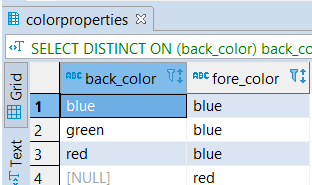

If save value does not contain primary key, it will execute Create, otherwise it will execute Update (with all fields). A discussion on this would be very beneficial.Save will save all fields when performing the Updating SQL db.First(&user) Even though the PK is (naturally) highly selective, I'm finding that indexes that start with the field(s) in the where clause to be better left-side columns. Say the join condition is on the PK, and there is a where clause on (an)other field(s). In terms of restrictions, this is equivalent to a UNIQUE NOT NULL constraint however, a table may only have one primary key, whereas multiple columns can be constrained as. In this statement, the id column is a primary key and email has a unique constraint, so PostgreSQL creates two UNIQUE indexes. CREATE TEMP TABLE test ( foo TEXT, bar TEXT, UNIQUE (foo, bar) ) INSERT INTO test VALUES ('foo', NULL), ('foo', NULL), ('foo', 'bar'), ('foo', 'bar') ON CONFLICT (foo, bar) DO.

I have problem with Postgres Unique constraint with multiple columns that may contain NULL value. If we add two different null values into a column in different. Have you got anything that talks about those conditions? In PostgreSQL, a primary key constraint indicates that a particular column (or group of columns) in a database table can be used to identify a unique row in that table. Postgres - Unique constraint with multiple columns and NULL values. When we are using the unique constraint, an index on one or more columns generate automatically. the indexes that the "Missing Index Details" in the SSMS 2008 Execution Plans generate vary greatly from I would think is the proper column layout for the index. I've been struggling with column order placement in indexes where the columns are used in join conditions and where clauses. If you use NULL instead of NOT NULL, the column will accept both NULL and non-NULL values. PostgreSQL can check the constraint in the list in any order. The order of the constraints is not important. For simple cases we can alternatively use Column(uniquetrue) or UniqueConstraint. Note that a column can have multiple constraints such as NOT NULL, check, unique, foreign key appeared next to each other. Lets define a unique constraint on the personNumber field: Column(unique.

The order that columns are specified in the table's definition has absolutely no meaning and no effect. uniqueness (multiple columns) and platform specific syntax. Not an answer for postgres, but may be useful nevertheless to someone using Oracle who stumbles across this: Oracle allows partial uniqueness to be enforced across multiple tables using a fast refreshing materialised view. multiple unique constraints, meaning unique constraints on multiple sets of columns. That's the order of columns in the index key. Or am I confusing this idea with guidelines for composite indexes, where the order of columns belonging to the index does make a difference?Ī unique constraint is implemented as a unique index, so order of columns matters just as much, and for the same reasons, as with a composite index. I want to add a unique constriant to the ObjectID column should that column come "before" other non-indexed or less unique columns, e.g. )WITH (PAD_INDEX = OFF, STATISTICS_NORECOMPUTE = OFF, IGNORE_DUP_KEY = OFF, ALLOW_ROW_LOCKS = ON, ALLOW_PAGE_LOCKS = ON) ON A unique constraint in PostgreSQL ensures that no two rows in a table have the same values in a specified column or set of columns. A Unique constraint can be defined on multiple columns by specifying it at table level. Given this table, which stores what are essentially workflow items,ĬONSTRAINT PRIMARY KEY CLUSTERED If I want to apply a unique constraint to a single column, does the order of that column relative to others make any difference?


 0 kommentar(er)
0 kommentar(er)
